Happy Hawaiian Trails
A leisurely road trip on the Big Island delivers an immersive journey in the culture and scenery of Hawai'i
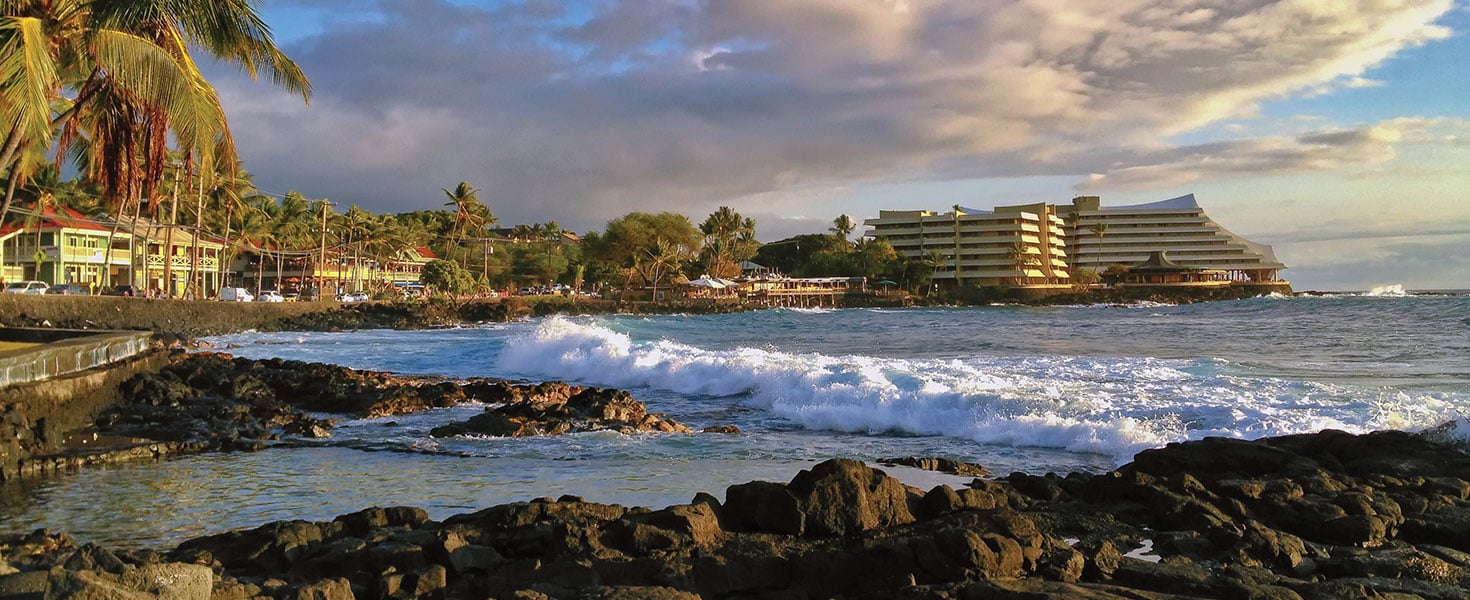

Once a sleepy fishing village, Kailua-Kona is now home to resorts, shops, restaurants and more. Photo by Samantoniophoto/Stock.Adobe.com
I’m floating facedown, bobbing on the ocean waves. Through my snorkel mask, I see a large shadow swirling in the dark waters below. A giant manta ray bursts into view. It’s 10 feet from tip to tip yet glides gracefully through the water.
Mouth wide open, the ray feeds on tiny plankton drawn by the lights in our canoe’s hull. The ray dives and flips, coming straight toward me. Thrilled, I hold my breath as we come nearly belly to belly. Just a foot apart, I look into its eyes as it passes by. It’s the kind of encounter I’d hoped for during this trip to the island of Hawai‘i.
My husband, Benjamin, and I are on a nighttime manta ray snorkel experience with Anelakai Adventures, a locally owned outfitter. Anelakai takes a different approach to ocean excursions. Instead of using a motorboat, the six guests and several guides paddle out in a double-hulled canoe. Great care is taken not to disturb the animals. We simply float and watch their dance below.
The ocean adventure is the kickoff to our road trip on the island of Hawai‘i, also known as the Big Island. We’ve visited several times before, but this is our first island road trip. We plan to spend six days exploring its beaches, rainforests, volcanic mountains and lava deserts.
You can drive around the largest of the Hawaiian islands, which is about the size of Connecticut, in eight hours, but why rush? We plan to take our time exploring the Big Island’s different regions, which are delineated by five volcanoes—Kīlauea, Mauna Loa, Mauna Kea, Hualālai and Kohala—that create climate zones, from damp tropical to hot desert to polar tundra. From the moment we landed at Kona International Airport, built on an 1801 lava flow, we were introduced to the island’s volcanic roots.
 With a protected bay, Kahalu‘u Beach Park offers some of the island’s most accessible snorkeling. Photo by PhotoImage/Stock.Adobe.com
With a protected bay, Kahalu‘u Beach Park offers some of the island’s most accessible snorkeling. Photo by PhotoImage/Stock.Adobe.comKAILUA-KONA: TWO NIGHTS
Like many visitors, our first stop is Kailua-Kona, 15 minutes south of the airport. Once a sleepy fishing village, it’s now home to resorts, shops, restaurants and beaches.
Our base is the Courtyard Marriott King Kamehameha’s Kona Beach Hotel, which overlooks picturesque Kamakahonu Bay. The resort is known for its thrice-weekly Island Breeze Lu‘au and the many watersports that can be enjoyed in the bay.
For me, Hawai‘i means time at the beach. The Big Island offers some of the best snorkeling and diving in the Hawaiian Islands. Among my favorite snorkeling spots is Kahalu‘u Beach Park, which is not far from Kailua-Kona. Reefs protect the bay, providing safe waters and abundant sea life; I see a spotted boxfish with big doe eyes, comical bluespine unicornfish, yellow tang and more.
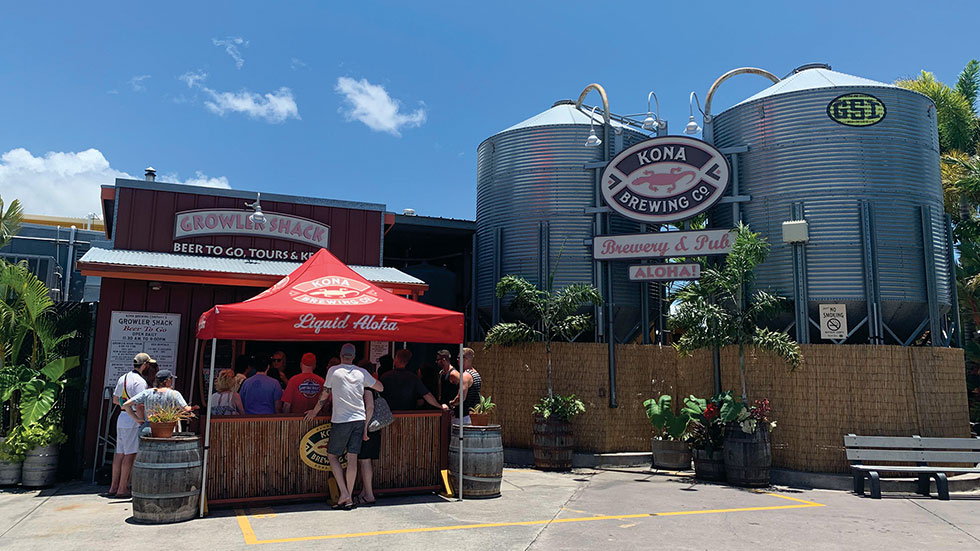
Kona Brewing Co. is among the largest craft breweries in Hawai‘i, with its original brewpub in Kailua-Kona. Photo by Janna Graber
Before dinner on our first night, we stop at Kona Brewing Co., among the state’s largest craft breweries, to sample several beers. One of my favorites is the Lemongrass Luau, a blonde ale brewed with ginger and lemongrass.
The next morning, we follow the coast south to Pu‘uhonua o Hōnaunau National Historic Park. The 180-acre park holds an important place in Hawaiian culture. It was once the Royal Grounds for ancient Hawaiians and a place of refuge for those who broke sacred laws.
If someone violated the sacred laws, their only chance at redemption was to make it to the Place of Refuge. The site possessed the mana (spiritual power) of the 23 al’i (chiefs) whose bones were protected in the Hale o Keawe temple. Pu‘uhonua o Hōnaunau served Hawaiians for hundreds of years until Kapu ended in 1819.
We embark on a self-guided walking tour through the Place of Refuge and the Royal Grounds, learning more about early Hawaiian culture. We stop at the Keōua Stone, the favorite resting place of the high chief of Kona and view Keone‘ele Cove, the royal canoe landing. Today, Pu‘uhonua o Hōnaunau remains one of the state’s most sacred historic places.
Continuing south, we stop at Punalu‘u Bake Shop, the southernmost bakery in the US. It specializes in malassadas, fruit-filled sweet rolls that were introduced to the islands by Portuguese immigrants and are now a Hawaiian favorite.
Then it’s on to Punalu‘u Black Sand Beach. The island has white, salt-and-pepper and green sand beaches, too, but Punalu‘u is one of the most beautiful of all, with a sand bay ringed by tall coconut trees. We’re delighted to see four large Hawaiian green sea turtles resting on the shore.
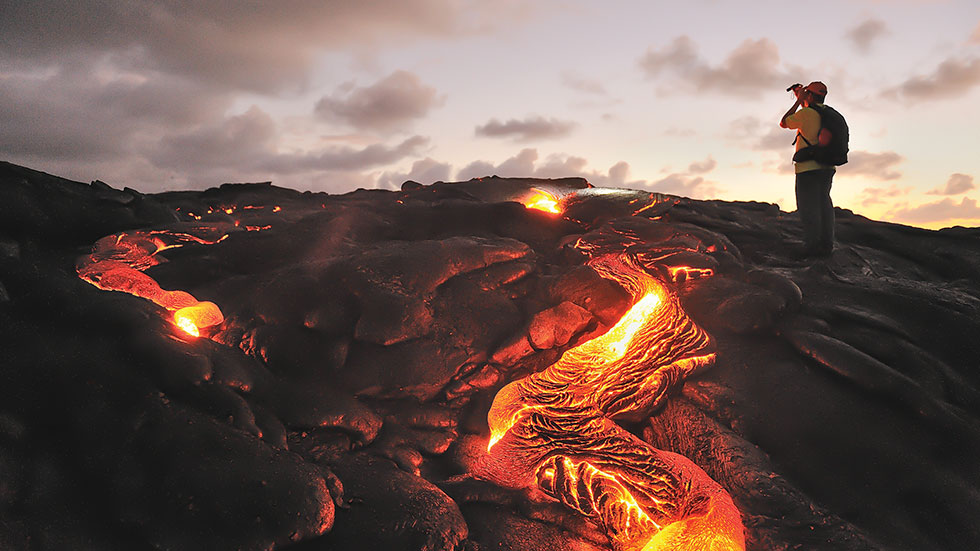
A visitor watches lava flows from Kīlauea Volcano at Hawai‘i Volcanoes National Park. Photo by Tamela/Stock.Adobe.com
HAWAI‘I VOLCANOES NATIONAL PARK: TWO NIGHTS AT KILAUEA LODGE
Soon, it’s time to head to Kilauea Lodge, a charming lodge in the rainforest at the foot of Mount Kīlauea. This will be our base for the next two nights as we explore Hawai‘i Volcanoes National Park. We arrive just in time for dinner at the lodge’s restaurant, which specializes in dishes that use ingredients from local farmers.
We’re excited to spend the day at the national park, so we set off early the next morning. (The park can get crowded, so try to arrive before 9 a.m. or after 9 p.m.; it’s open 24 hours.) The island of Hawai‘i has two active volcanoes: Mauna Loa and Kīlauea, and both are part of the national park. Mauna Loa, the largest active volcano on the planet, makes up 51 percent of Hawai‘i Island, but Kīlauea is the main attraction at Hawai‘i Volcanoes National Park. The volcano produced steady lava flows for years, drawing visitors from all over the world. Since 2018, eruptions and lava flow have been off and on.
Our first stop is the visitor’s center, where we learn that Kīlauea and Mauna Loa are sacred landscapes deeply connected to Native Hawaiian culture. We hike along a paved trail to the crater, watching in awe as steam rises from vents in the earth.
While we didn’t see any lava flows during our visit, at press time, Kīlauea Volcano was erupting again within Halema‘uma‘u Crater. It has created a huge lava lake and lots of excitement at the park, where lava is visible from many areas and overlooks.
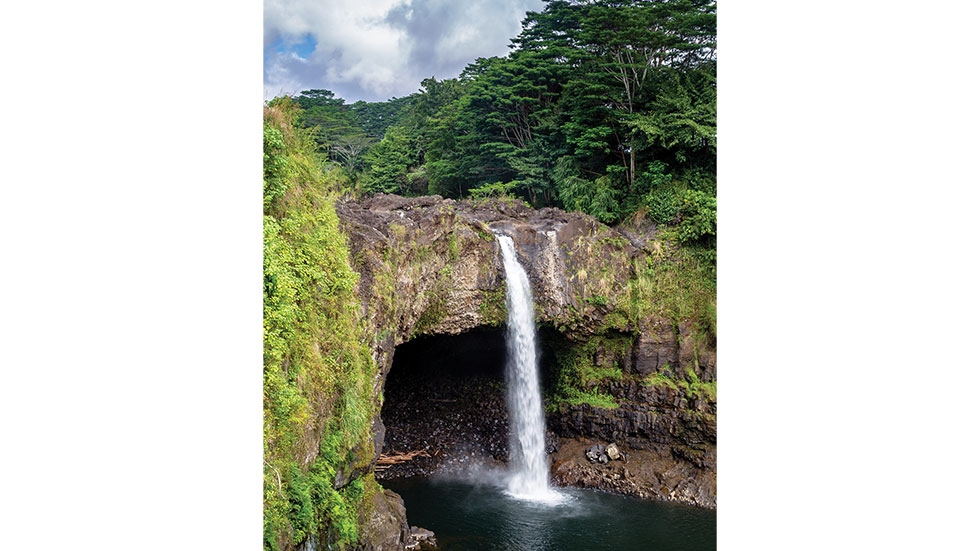
Rainbow Falls in Hilo often serves up a stunning combination of rainbows and waterfalls. Photo by DirkR/Stock.Adobe.com
That Hawai’i truly is the land of rainbows and waterfalls becomes obvious the next morning when we head to Hilo, the island’s second-largest town. First, we stroll through the free Lili‘uokalani Gardens, a 25-acre Japanese garden dedicated in 1917 to Hawai‘i’s first Japanese immigrants, who worked the sugar cane fields. Rainbow Falls is another free must-visit in Hilo. In the morning, when the sun faces the waterfall, you can often see rainbows. The combination of rainbows and waterfalls enchants us. We snap a few photos and then sit and listen to the peaceful sound of the falls.
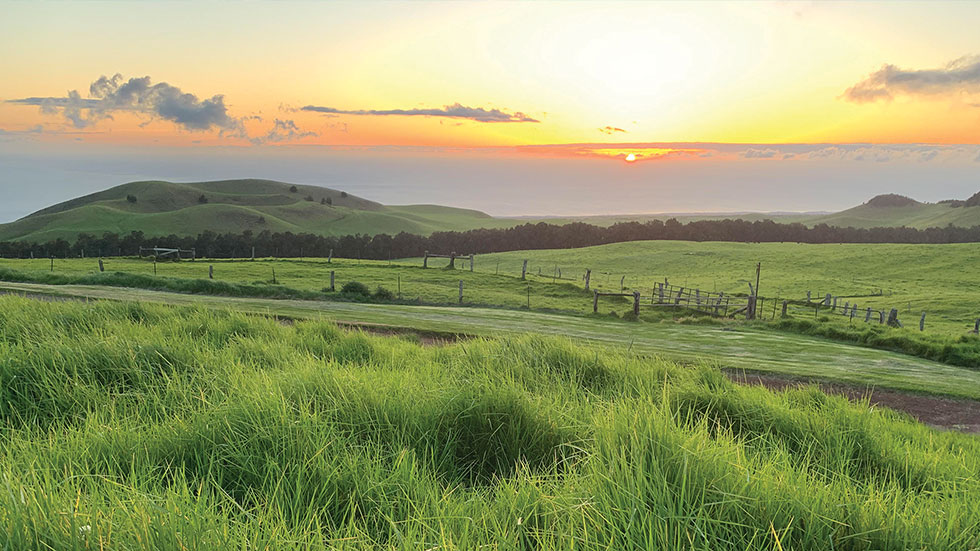
The sun sets over Kahua Ranch in North Kahala. Photo by Janna Graber
KOHALA COAST: TWO NIGHTS
By evening, we reach the Kohala Coast, home to white sand beaches and luxury accommodations. Our hotel, the Fairmont Orchid, has more than 30 acres of lush tropical gardens and waterfalls. We enjoy fresh seafood, locally grown produce and Hawaiian cuisine during a sunset dinner on the beach at the resort’s Brown’s Beach House. The romantic setting gets even better as the sun begins to sink below the horizon, painting wide swathes of orange across the sky.
The next morning, I book a traditional massage at the resort’s Spa Without Walls, where services are provided in cabanas beside a waterfall or the ocean. I choose the Awa Earth Fire treatment, a Hawaiian detoxifying treatment that begins with a lomi lomi massage, an ancient Hawaiian healing practice that uses long, flowing strokes.
Then we’re off to see the Kohala Coast. The terrain becomes greener the farther north we go. We stop in Hawi, a former sugar-cane plantation town, which is small and walkable, and savor cups of coffee at Kohala Coffee Mill.
A few miles up the road is Kapa‘au, where we stop for lunch at Minnie’s Ohana Lim Style Café. Sitting on the porch, we enjoy every bite of our fresh fish, two scoops of rice and macaroni salad. Standing tall in the center of town is its icon: an 18-foot bronze statue of King Kamehameha I, known for unifying the islands into one kingdom. We stop to read more about him before continuing on our way.
For dinner, we drive to Kahua Ranch, a working cattle ranch that welcomes visitors for a sunset barbecue each Wednesday. At the ranch, we learn that the Big Island’s ranching roots run deep, and North Kohala is cowboy central. George Vancouver, an explorer who traveled with James Cook, gifted King Kamehameha I with five longhorn cattle in 1793. When the king’s herd grew larger, he invited paniolos (Mexican cowboys) to the island to manage them. Today, we’re told, Hawaiian cowboys are still called paniolos, and ranching plays an important role in the local economy.
After dinner and line dancing, we watch the sun slowly set. Orange and pink streaks cross the horizon, silhouetting the grazing cattle and horses, and a warm breeze blows in from the ocean. It’s the perfect way to end our road trip in Hawai‘i.
ROAD TRIP TIPS
Be sure to reserve your rental car well in advance, as rental car inventory remains low. Plan to take your time when driving in Hawai‘i. Speed limits on nonresidential roads are 45 miles per hour, and on rural freeways, they are 50. Google Maps is a useful tool for navigating the island.
